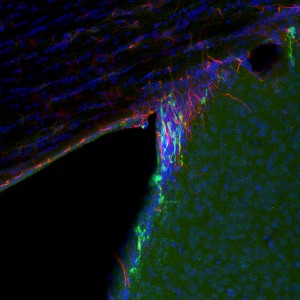2021-09: Welcome to our new RA, Moesha Parsons!
2021-08: Good luck to Becca in graduate school! We look forward to seeing you around VU!
2021-07: Mary is honored with the Dean's Award for Exceptional Achievement - we and the Ess lab are very proud of you!
2021-07: Congrats Laura!! F31 funded!
2021-01: Congratulations to Laura on your first author paper!
2020-08: Welcome to our new RA, Becca Embalabala!
2020-06: Justine and Gabrielle's collaborative work with the Ess and Carson lab is now online at Neurobiology of Disease. Congratulations all!
2020-06: Justine and Nalin's paper is now up at eLife.
2020-05: Congratulations to Justine on her successful PhD defense!!
2019-11: Rebecca is promoted to Associate Professor.
2019-09: Gabrielle and Maddi's book chapter is now online.
2019-08: Asa's collaborative work with the Freeman lab now online at Stem Cells.
2019-06: Way to go, Justine - two talks and a poster at two national meetings within two weeks!
2019-05: Congratulations to Ethan - the 2019 Founder's Medalist for the College of Arts & Sciences.
2019-05: Gabrielle successfully defends! Congratulations Dr. Sandusky!!
2019-05: Collaborative work with the Irish lab on mass cytometry (and identification of prognostic cell populations) now on BiorXiv.
2019-04: Congratulations to Ethan and Maddi for successfully defending their Honors undergraduate theses. We will miss you!
2019-04: Come see Rebecca speak at the EBC/Stem Cell symposium on campus April 4th.
2019-03: Gabrielle's paper on tumor cell of origin in Tuberous Sclerosis Complex is now out in Life Science Alliance. Congratulations!
2019-02: Mistry's latest paper on V-SVZ-contacting brain tumors is now out in Scientific Reports.
2018-11: Rebecca's minireview (with colleagues) on Shh signaling is now out in J Neurosci.
2018-10: Congratulations Laura - Best Talk award at Pharmacology retreat!
2018-09: Justine wins Runner-Up for Best Presentation at the PDB annual retreat. Way to go!
2018-08: Amanda wins the Outstanding Oral Presentation Award for her summer research project and is featured in the VUMC Reporter. Way to go Amanda!
2018-06: Welcome to our VSSA student Amanda Blythe from U Missouri!
2018-05: Welcome new Pharmacology Ph.D. student Laura Winalski!
2018-04: Congratulations to postdoctoral fellow Todd Bartkowiak on your NCI K00 award!
2018-03: Congratulations to Nalin (comentored with the Irish lab) on your successful Ph.D. defense and residency match (Yale/Pathology)!
2018-01: The Ihrie and Ess labs are awarded pilot funding from the Vanderbilt Brain Institute TiPs program to develop mass based imaging in brain.
2017-10: Congratulations Justine and Bret on your accepted review article for the American Journal of Pathology!
2017-9: Dr. Ihrie and Dr. Irish receive the Ann Faulkenberry Memorial Award at the Southeastern Brain Tumor Foundation Race for Research.
2017-7: The lab is thrilled to have been selected for a research grant from the Southeastern Brain Tumor Foundation. See you at the Race for Research in September!
2017-5: Amanda wins the 2017 Founders Medal, and Divya is Salutatorian for the MLK Jr. Magnet Class of 2017.
2017-4: Current Protocols article now available online for dissociation of solid tumors for analysis using mass cytometry.
2017-3: Congratulations to Mistry on receiving the The Society of Neurological Surgeons/RUNN Resident Award to support your research!
2017-2: Nalin receives the AACR - ABTA Scholar-in-Training Award for her upcoming poster at AACR!
2017-1: Congratulations, Mistry - second accepted article in J Neuro Oncology!


